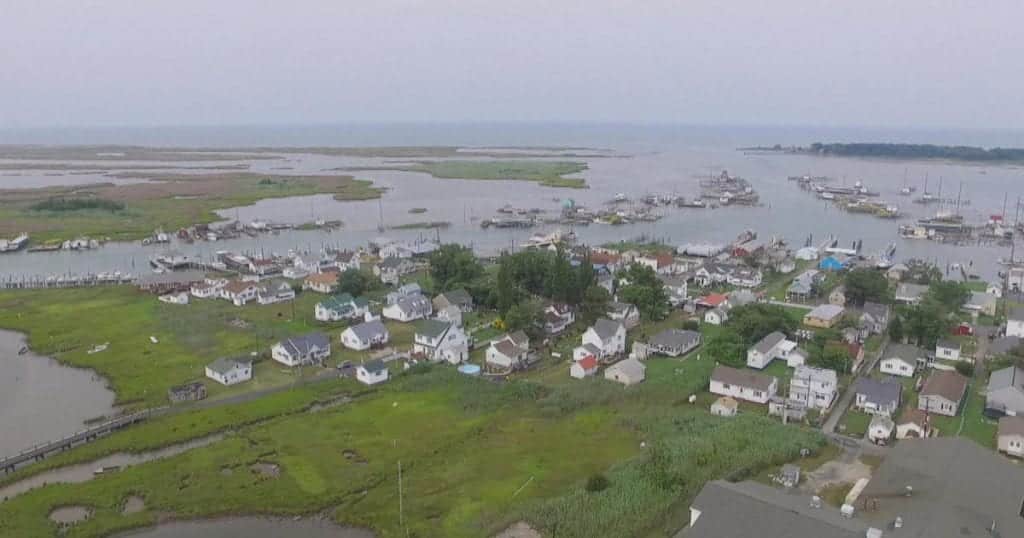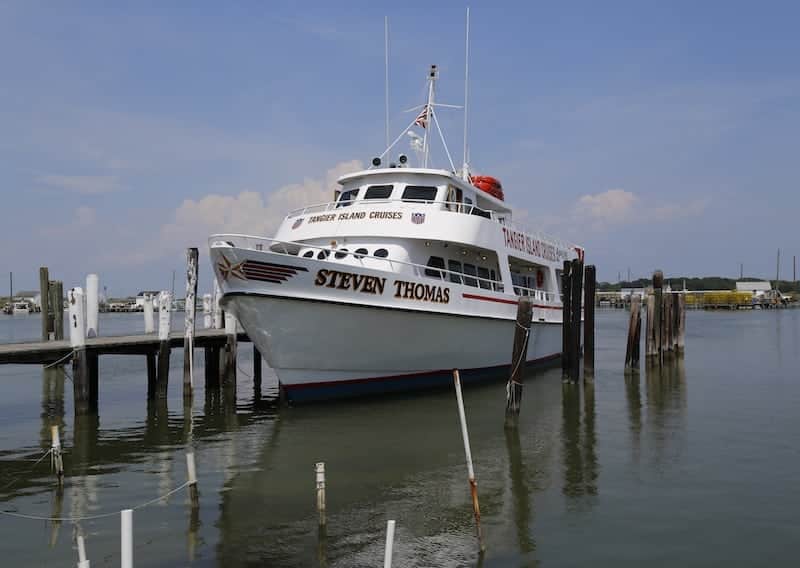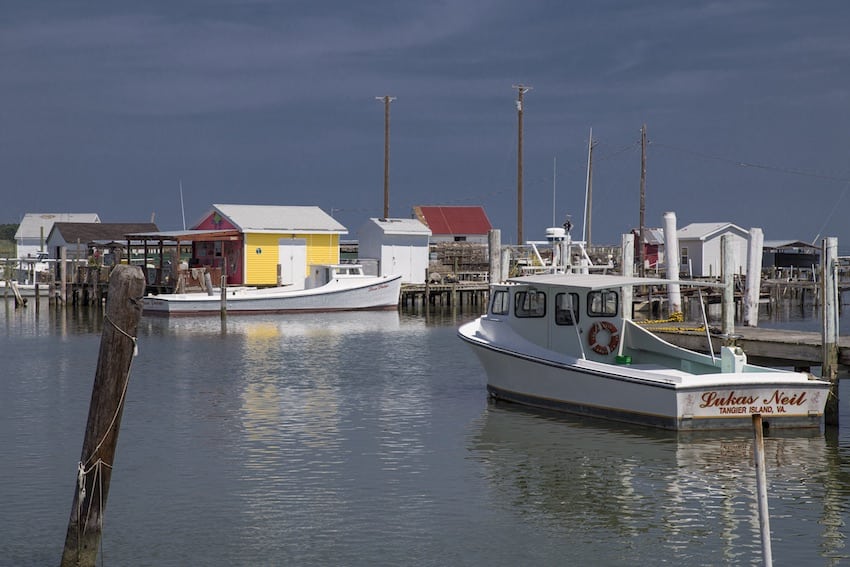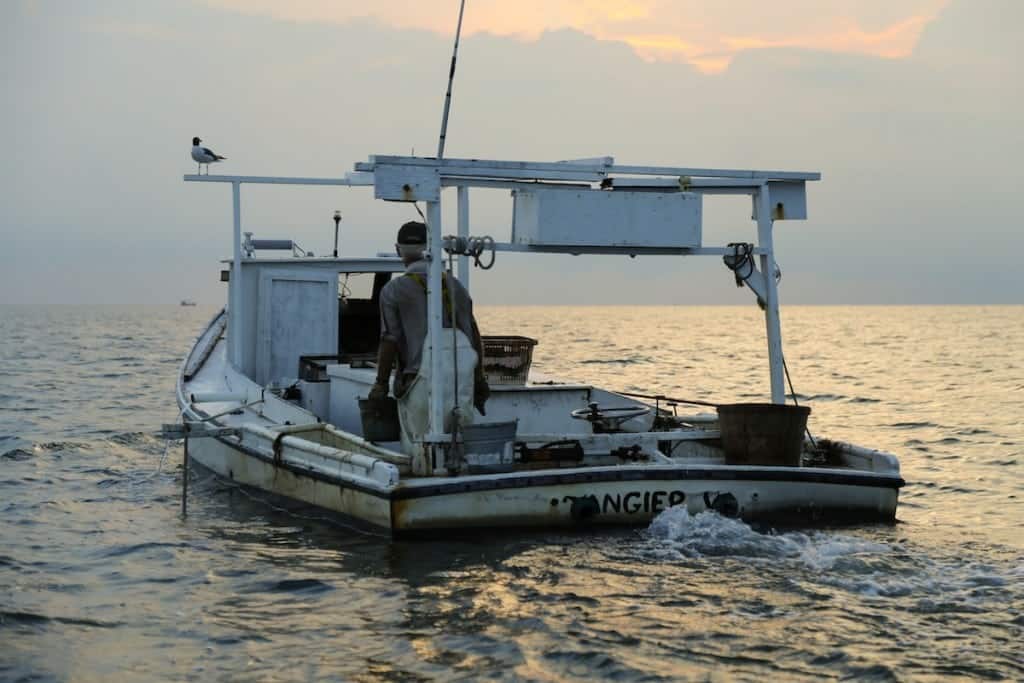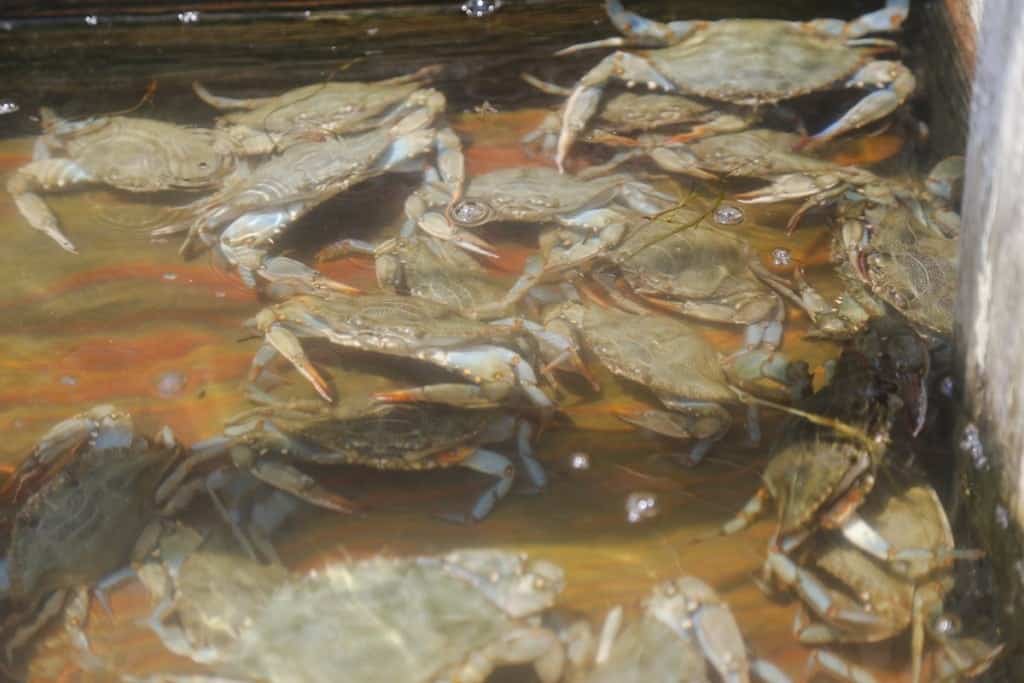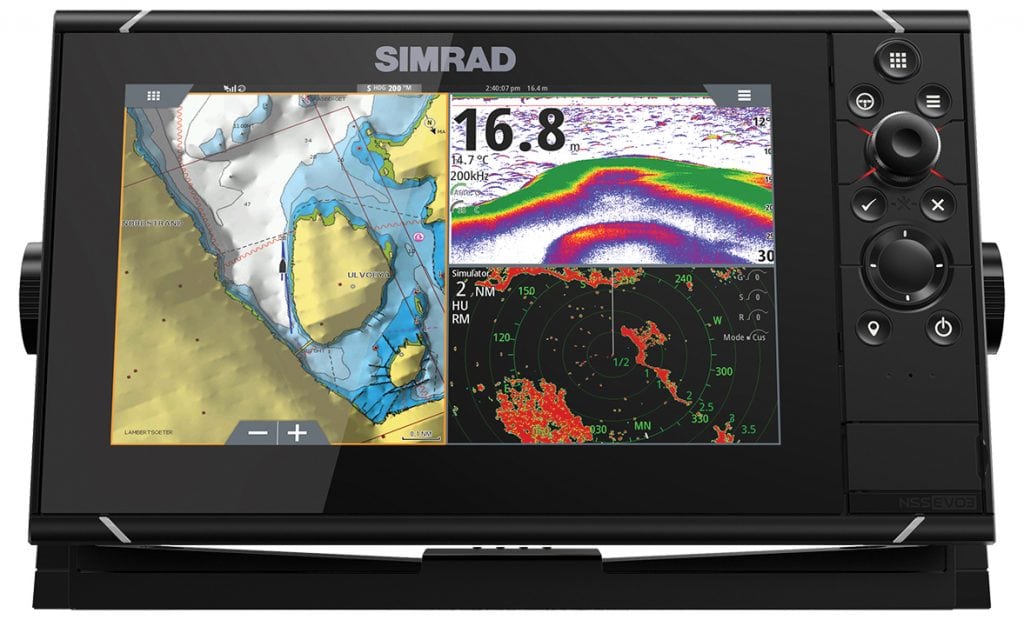[vc_row][vc_column][vc_column_text]
Tidewater Time Machine
Tangier Island is a remote, rustic and beautifully weathered area occupied by seafaring residents who speak a tongue stained with a dialect from their Old English ancestors and a surprising diversion from more typical and mainstream Chesapeake Bay cruising locales.[/vc_column_text][vc_column_text]Lying nearly in the middle of Virginia’s emerald-green Chesapeake Bay waters, Tangier Island is a tiny sliver of marsh-peppered sand measuring just a mile wide by three miles long. It is so isolated that it can only be reached by boat.
The island’s residents stubbornly cling to every last inch of what’s left, as wind, waves and climate change steadily wash pieces of it away forever. Adversity and rugged beauty have left a charming patina on the island.
Visiting Tangier feels like going back in time. Folks crisscross the island using motorized and electric golf carts and scooters. Sometimes travel by outboard-powered skiff proves far more efficient than any other mode of transportation. You can’t buy liquor here, and the locals are quite conservative about outsiders consuming any bootleg booze they’ve brought along with them, as religious faith plays an important role in islanders’ lives. A doctor visits the local medical clinic once a month by helicopter, when weather permits.
Even electricity is piped in from the mainland. Still, Tangier’s residents relish their individuality and freedom. Visiting the island to soak in their culture and way of life—as well as to experience Tangier’s amazing scenery and wildlife— is well worth the pit stop.
Discovered more than 400 years ago by Captain John Smith, Pocomoke Indians occasionally inhabited the island before it was fully settled around 1686 by a Cornishman named John Crockett. Today, the last names of 450 permanent residents also include Pruitt, Thomas, Parks, and Evans. Many centuries of isolation have left locals with a heavy accent handed down by their Cornish ancestors, a sort of Old English similar to the thick brogue some Downeast North Carolina residents speak. Tangier’s population swells and recedes by a few hundred each day as tourists arrive and depart on ferry boats to get a look at the place and bolster the local economy in the process. Tourism aside, the island’s rhythm from April until November is dictated by crabbing. Today, some 70 watermen continue to work the plentiful waters around Tangier.
There are two limiting factors when it comes to cruising the area: your boat’s draft and your need for supplies. If your boat draws more than about six feet, dock in Crisfield, Maryland, and take the daily ferry to Tangier Island, about 15 miles across Tangier Sound. The Steven Thomas (800-863-2338) leaves Crisfield at 12:30PM daily and returns from Tangier, departing at 4PM sharp. Other ferry services include the Joyce Marie II (757-891-2505) from the eastern shore town of Onancock, Virginia, or the Chesapeake Breeze (804-453- 2628) from the western shore hamlet of Reedville, Virginia.
Other ferry services include the Joyce Marie II (757-891-2505) from the eastern shore town of Onancock, Virginia, or the Chesapeake Breeze (804-453- 2628) from the western shore hamlet of Reedville, Virginia.
Cruisers who want the full Tangier experience stay at Park’s Marina, the island’s sole marina, which has 25 slips and showers for slip holders but no pump-out. Fuel is available from two fuel docks on Tangier’s main watery thoroughfare.
There’s a general store and a few restaurants on Tangier but very little additional supplies, sundries or engine, and mechanical parts. There are, however, two motels and a handful of bed and breakfasts on the island. If you choose to visit by boat, there are two off-ramps from the main Chesapeake Bay channel into Tangier Island proper. The easiest approach is through what is identified as “Tangier Channel” on the chart but called “North Channel” by locals.
It lies on the west side of the island, starting at flashing green “1W” before making a dogleg at flashing green “3” and flashing red “4.” The other access is through the charted “Entrance Channel” to the east. This route requires rounding the Tangier Sound Light, keeping clear of green can “3,” and then pointing toward flashing green “1E” into the Entrance Channel. This passage has similar depths to Tangier Channel—around six feet at mean low water—but is considered somewhat more reliable because the ferry and mail/supply boats run it every day, helping to keep sediment from filling the channel in.
The first thing that will likely come into sight as you approach—by ferry or your own boat— are the many worn and weather-beaten crab shanties that line both sides of the thoroughfare. With dry land at a premium, watermen use these stilt-supported shanties as places to stow their crabbing and oystering gear and secure their boats. The two entrance channels eventually meet in the middle, forming a small harbor that is often the center of waterfront activity on the island. Small outboard-powered skiffs crisscross the harbor at a frenetic pace, interrupted only by the comings and goings of traditional Chesapeake deadrise workboats heading out to the crabbing grounds or returning home to sell their catch. Buyboats from the mainland visit the island daily to secure these catches and return them to shoreside processing facilities. Watching—and listening to the banter during the transfers—can be quite entertaining.
If you have an outboard-powered dinghy, poke in and out of Tangier’s interesting nooks and crannies. Start by motoring slowly along the waterfront where watermen at their crab shanties work on their nets and crab pots or tinker with the engines on their boats. The handful of shanties with water pouring from them are soft-shell crab shedding facilities.
Blue crabs grow by occasionally shedding their hard exoskeleton for a larger shell. These shedding facilities buy crabs scraped up or trapped by watermen from the local grass flats and then put them in pens until they shed. Once a crab discards its old shell, it must be immediately plucked from the water or the shell will quickly harden. This makes shedding crabs a 24/7 operation. Once you’ve had a soft-shell crab sandwich, you’ll realize the hard work is worth it.
You can also take your dinghy to some of the marsh islands north and east of Tangier. The Uppards, a collection of islands north of Tangier proper, is particularly fascinating. Once inhabited, they are now abandoned and actively being washed away leaving hints of civilization, including headstones and human bone fragments that lie in the wash zone scoured by the waves. Indians left items behind here, too. A careful eye can find an arrowhead or two in the sand on a walk around the shoreline. Port Isobel is an island just east of Tangier and owned by the Chesapeake Bay Foundation. They’re friendly to visitors, and the area is great for birdwatching.
No matter which marshy island you set foot on, biting black flies take painful chunks out of visitors not covered in insect repellent; you’ve been warned. Once you’re back ashore, walk around the island—or rent a golf cart—to take in the scenery. Don’t be surprised by the cemeteries in many of the homes’ front yards. Space is a premium on the island, so some families use their own land for laying relatives to rest. You’ll also see huge stacks of orange and yellow crab pots, beautiful old churches and homes with no lack of character and interesting style.
Visit the Tangier History Museum (16215 Main Ridge Road, 757-891-2374) for the local scoop, so to speak, and learn how the island has changed over the years. A trip to Tangier isn’t complete until you’ve sampled locally caught seafood that’s prepared in true Chesapeake style. Soft-shell crabs and crab cakes are a favorite on the island, and the folks at Fisherman’s Corner know how to prepare them just right.
Four Brothers Crab House and Ice Cream Deck is also a great place to grab a crab cake or soft-shell sandwich to go, but you should make it a point to get ice cream one evening and enjoy it on the deck outside the take-out window. Here, you can listen to the locals talk politics and engage in gossip with their unique and colorful accents. Lorraine’sSnack Bar is another joint serving great seafood sourced from local waters.
Visit Tangier while you can. Scientists estimate it may be overcome by water completely within 50 years, if the current rate of sea level rise continues. When you get there, you’ll discover a beautiful, rugged place populated by interesting folks who march to the beat of their own drummer, no matter what Mother Nature throws their way.
Cruiser Resources
DOCKAGE
Somers Cove Marina
715 Broadway, Crisfield, MD
(410) 968-0925
Park’s Marina
16070 Parks Marina Lane, Tangier, VA
(757) 891-2581
TANGIER RESTAURANTS
Fisherman’s Corner
4419 Long Bridge Road
(757) 891-2900
Four Brothers Crab House and Ice Cream Deck (also golf cart rental)
16128 Main Ridge Road
(757) 891-2999
Lorraine’s Snack Bar
(757) 891-2225
By Gary Reich Southern Boating
June 2017[/vc_column_text][/vc_column][/vc_row]

